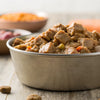Is Wet Food for Dogs Bad? Understanding the Pros and Cons of Feeding Wet Food
- Houndsy
Table of Contents
- Introduction
- Understanding Dog Food Options
- The Benefits of Wet Dog Food
- The Drawbacks of Wet Dog Food
- Considering Mixed Feeding
- Conclusion
Introduction
Picture this: it’s mealtime, and your beloved pup is staring up at you, tail wagging, eyes sparkling with anticipation. You open a can of delicious-smelling wet food, and your dog responds with excitement—instantly devouring it. Sounds great, right? But as dog owners, we often grapple with important questions about our furry friends' diets. One of the most common queries we find ourselves asking is, "Is wet food for dogs bad?"
The reality is that the decision between wet and dry dog food isn't entirely straightforward. As pet parents, we want to provide the best possible nutrition while considering our dogs' unique needs and preferences. With countless options on the market, choosing the right food can feel overwhelming. Additionally, wet food carries some distinct advantages—and potential downsides—that deserve exploration.
In this blog post, we will delve into the differences between wet and dry dog food, examining the benefits and drawbacks of feeding wet food to our canine companions. By the end, you’ll have a comprehensive understanding of whether wet food is right for your dog, empowering you to make informed choices. Let's embark on this journey towards elevating our pets' feeding experience together!
Understanding Dog Food Options
To begin our exploration, let’s familiarize ourselves with the two primary categories of commercially available dog food: wet and dry. Both serve as nutritional sources, but they differ significantly in composition, storage, and convenience.
Wet Dog Food
Wet dog food, often sold in cans or pouches, typically contains a higher moisture content—up to 75-78%—making it an appealing option for many dogs. Its texture and aroma often attract picky eaters, as it closely resembles the fresh meat that many dogs enjoy.
What’s more, wet food is prepared differently compared to its dry counterpart. It generally consists of ground protein sources mixed with vitamins, minerals, and grains, cooked and sealed in its packaging. This preparation method not only enhances flavor but also retains nutrients, appealing to dogs who may be less enthusiastic about dry kibble.
Dry Dog Food
Dry dog food, commonly referred to as kibble, generally has a much lower moisture content, typically around 10%. This makes it more shelf-stable and convenient for dog owners. Dry food production involves mixing ingredients into a dough, extruding it into specific shapes, and drying it to eliminate moisture.
While kibble is often easier to serve and store, it may not satiate every dog’s appetite, especially those that require extra encouragement to eat. Additionally, some kibble brands may be fortified with probiotics or added dental health benefits.
Both wet and dry dog foods can provide balanced nutrition, but each has its pros and cons. Let’s dig deeper into these now.
The Benefits of Wet Dog Food
1. Higher Moisture Content
One of the key advantages of wet dog food is its significantly higher moisture content. Staying hydrated is crucial for dogs' overall health, particularly for those prone to urinary or kidney issues. Wet food can be particularly beneficial for pets who do not drink enough water, as it adds extra hydration during mealtimes.
2. Enhancing Palatability
It is no secret that most dogs find wet food irresistible due to its rich aroma and flavor. This makes it an excellent option for picky eaters or dogs undergoing recovery from illness. If your furry friend has a decreased appetite, incorporating wet food can make meals more enticing and enjoyable.
3. Increased Satiety
Dogs often feel fuller after eating wet food due to its water content and dense nutritional profile. This can be particularly helpful for managing weight or ensuring our pets stay satisfied throughout the day.
4. Easier to Chew
For older dogs or those with dental issues, the soft texture of wet food is easier to chew and digest. This makes it a practical alternative for pets who may struggle with harder kibble.
5. Variety and Flavor
Wet dog food offers an array of flavors and textures, many of which appeal to your dog's palate. With choices ranging from chicken to lamb and fish to beef, this variety can help prevent meal fatigue in your canine companion.
The Drawbacks of Wet Dog Food
1. Cost Considerations
While wet food has many benefits, it tends to be more expensive than dry dog food. Depending on your budget and the amount your dog needs, this difference in price may significantly impact your pet food expenses over time.
2. Convenience and Waste
Unlike dry kibble, wet food has a limited shelf life once opened. Any uneaten portion must be stored in the refrigerator and used within a few days. This can create waste if your dog does not finish their meal promptly.
3. Dental Health Risks
While wet food offers many advantages, it may not contribute to good dental health in the same way dry food does. The gritty texture of kibble can help reduce tartar buildup, while wet food does not have this benefit. For this reason, it is important to incorporate regular dental care, such as teeth brushing or dental chews, into your dog’s routine.
4. Potential for Higher Fat Content
Wet dog food can occasionally contain more fat than dry forms, which may not be suitable for all dogs. Dogs predisposed to pancreatitis or those with particular dietary restrictions must be closely monitored regarding fat intake.
5. BPA and Container Concerns
Certain wet food cans may be lined with Bisphenol A (BPA), a chemical that can leach into the food. As pet owners, it’s important to be mindful of selecting high-quality brands that minimize the risk of exposure to potentially harmful substances.
Considering Mixed Feeding
Many pet owners find themselves pondering the ideal diet for their dogs. One increasingly popular approach is mixed feeding, which involves combining wet and dry dog foods. This method can provide the best of both worlds, allowing our dogs to enjoy the benefits of both textures and flavors while balancing nutrition.
Benefits of Mixed Feeding
-
Enhanced Flavor and Variety
- Mixing wet and dry food can create a more flavorful, enjoyable meal experience for our dogs.
-
Improved Hydration
- By incorporating both types of food, we ensure that our pets receive adequate moisture while still benefiting from the convenience of dry kibble.
-
Balanced Nutrition
- A blended approach allows us to make use of the advantages from both forms, creating a well-rounded diet tailored to our pets' individual nutritional needs.
Tips for Successfully Mixing Foods
-
Consult with Your Veterinarian
- Before transitioning your dog to a mixed diet, it is crucial to speak with your veterinarian about their specific nutritional requirements.
-
Portion Control
- Adjust the portions of both wet and dry food according to your dog's daily caloric needs, ensuring you avoid overfeeding.
-
Gradual Transition
- If you decide to introduce mixed feeding, do so gradually over several days to allow your dog to adapt without digestive issues.
Conclusion
So, is wet food for dogs bad? The answer is nuanced. Wet food offers an enticing combination of flavor, hydration, and nutritional quality that can greatly benefit many dogs. However, we must also be aware of its drawbacks, including potential dental issues and cost. Ultimately, we encourage dog owners to consider their pet’s individual needs, preferences, and any specific recommendations from a veterinarian when deciding between wet food, dry food, or a combination of both.
At Houndsy, we believe in elevating the feeding experience. Our commitment to quality and functionality extends to ensuring that mealtime is convenient, beautiful, and fulfilling. By blending the best aspects of various dog foods and using innovative products, such as the Houndsy Kibble Dispenser, we can simplify and enjoy mealtime with our pets.
FAQs
1. Can dogs survive solely on wet food?
Yes, many dogs thrive on a diet of solely wet food, provided that it meets their nutritional needs.
2. Is it safe to mix wet and dry food?
Absolutely! Mixing wet and dry food can enhance your dog’s meals and provide a more balanced diet.
3. How do I know if wet food is right for my dog?
Consult your veterinarian to assess your dog's unique needs and preferences. Consider factors such as age, size, health, and any special dietary requirements.
4. Does wet dog food spoil quickly?
Yes, once opened, wet dog food should be refrigerated and consumed within a few days.
5. What can I do to maintain my dog’s dental health on a wet food diet?
Incorporate regular dental care routines, including brushing, dental chews, and veterinary check-ups, to support dental health alongside a wet food diet.
By understanding the nuances of varying dog food types—especially wet food—we can ensure that our furry friends remain happy and healthy. Our mission at Houndsy is to enhance this experience, making it enjoyable for both pets and their loving owners.












